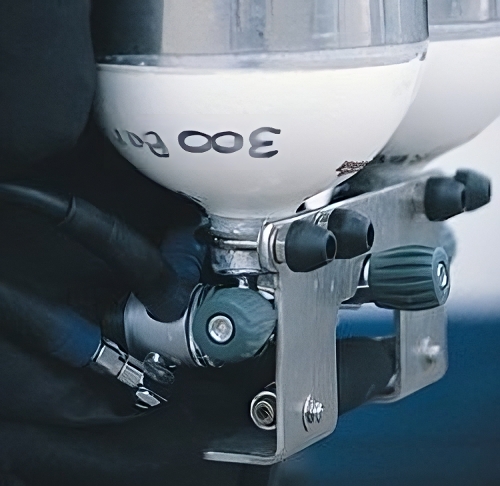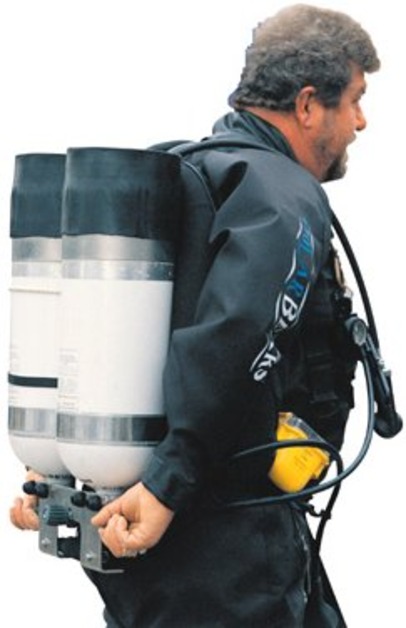No, there's no mistake! Nick Herbert's twinset (opposite) is meant to be worn upside down. It's a little wrinkle he has borrowed from Royal Navy divers that enables him to turn his air on and off without struggling to reach valves between his shoulder blades.
Follow his example and you'll find it less of a sweat next time your regulator goes into free flow.
You know what it's like when you get one of those itches in the upper part of your back? Slap-bang between the shoulder blades, in an area that you just cannot reach to scratch, no matter what contortions you perform?
As a keen diver, you have decided to invest in a twinset with manifold and two good-quality regulators. You might also have opted for an isolating valve in that manifold, so you now have a high degree of equipment redundancy.
Now imagine that same unreachable itch turned into a problem with one or other of your regulators to the extent that a massive coldwater free-flow is venting your vital air supply into the surrounding water.
If you are well into a long, deep dive when this occurs, a rapid ascent to the surface might not be high on your list of sensible options yet.
But your buddy has his head buried in a particularly interesting hole in the wreck you are diving, so has not noticed the little drama unfolding outside.
What you can do is turn off the offending cylinder pillar valve. You are naturally diving this deep with either trusty twins or a pony strapped to your main cylinder.
This will stop the flow from your frozen DV while you breathe from the other system.
And it is quite possible that the offending regulator will warm up once all that high-velocity, low-temperature gas stops roaring through it, to a point where the ice melts and everything works as advertised.
Just one slight problem remember that itch? You've guessed it: your arm is not long or flexible enough to reach any of the valves, especially when layered in long-sleeved T-shirt, woolly bear and drysuit.
The needle on your pressure gauge is falling like secondhand Skoda prices and your feeling of being in control is dwindling in proportion to your primary air supply.
Let's hope your buddy gets his head out of that hole fast. But things need not happen this way.
For many years Royal Navy divers have been using a very simple scuba system that consists of a twinset with manifold, one first and one second stage and no contents gauge at all.
They simply shut off one cylinder pillar valve, then breathe off the other one until it is nearly empty and they sense an increasing breathing resistance.
That is when they reach behind them, open the previously closed pillar valve and decant air from the full cylinder to the empty one.
They then shut off the “donor” cylinder again. This decanting process is carried out twice. Then, with 50 bars left in each cylinder (from an initial 200 bar fill), it is time to head back to the surface.
That's how the Navy does it, but how does that help our diver in trouble, struggling to reach behind his back? Easy the thing I hadn't mentioned about those Navy divers is that they wear their twinsets upside down.
Try it yourself it's much easier to reach a valve in the region of your kidneys, and you can get to either valve of a manifolded twinset with either hand, in case one arm is tangled up in netting or otherwise incapaci-tated.
You will need longer hoses for the second-stage and BC direct feed, but most regulators are available with a variety of longer octopus-length intermediate hoses, and the same goes for direct feeds.
You need only two long hoses, because a normal hose for a drysuit direct feed is just right when the system is worn inverted, and contents-gauge hoses will if anything be too long, and need to be clipped to the BC, out of the way.
What of damage to the cylinder valves if you sit down on a hard boat deck? Again, there is a simple solution. Cave-divers fit stainless-steel valve protectors, usually home-made, to their twinsets.

The Stainless Valve Guards shown in the pictures were supplied by Forward Diving Services of Poole, which also offers a range of cylinder twinning bands and any length of hose needed for second-stages and direct-feeds.
The hoses shown here for the Oceanic Omega second-stage and the Apeks Octo Plus that doubles as my octopus are both 106cm long.
Fitting the cylinders to a BC backpack or wings is simply a matter of turning them upside-down and doing up either the wingnuts or cambands, whichever your system uses.
But (and this is a big “but”), you will have to get into the habit of fitting your regulators before attaching the BC or wings to your cylinders.
The long second-stage and direct-feed hoses pass up the centre of the cylinders to give a normal “over-the-shoulder” orientation, which is difficult to achieve if you have fitted cylinders to BC first.
So that is the set-up: your usual twinset with second-stage directed neatly over the right shoulder, the direct feed over the left, contents gauge(s) clipped to the bottom of the BC and your suit feed hose coming upwards under the right arm to the chest inflator valve.
Put it on, then reach behind you to turn your air on or off without struggling, complete buddy checks and set off for a stretch-free dive. Try it you'll like it.

